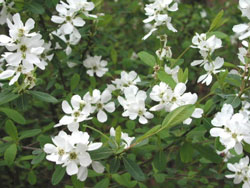Resource Library
Plant of the Week: Pearlbush
The University of Arkansas System Division of Agriculture does not promote, support or recommend plants featured in "Plant of the Week." Please consult your local Extension office for plants suitable for your region.
Plant of the Week
Pearlbush
Latin: Exochorda racemosa

During the 20th century, American gardens went through a transformation towards greenness.
A century ago, the shrubs in most American gardens were leafless in winter with spireas, lilacs, flowering quince, mock orange and forsythia being common. Evergreens such as yews and junipers began more common early in the century but azaleas and hollies didn't appear until mid-century.
Pearlbush, though no longer common, was one of the deciduous shrubs of this bygone era.
Pearlbush (Exochorda racemosa) is a member of the rose family and most closely related to the spireas, except pearlbush has a larger flower more reminiscent of an apple. It's a large shrub, growing 12 feet tall and wide, with thick, brown stems and a coarse overall texture.
Four species are known, with two in China and two in adjacent areas of central Asia.
Leaves appear early in the spring before flowering and are a medium green, whitish beneath, and 2- to 3 inches long. Unfortunately they don't produce any fall color. Odorless, pure white flowers are 1.5 inches across, five-petaled, with each petal narrowing at the base and produced from a cuplike calyx appear in mid-spring. Flowers are produced on a raceme at the end of each branch and, just before they fully open, resemble a strand of pure white pearls.
The name Exochorda comes from a cord (exo, or outside, and chorde, a cord) that forms around the developing ovary, producing a dry fruit with five prominent ridges when it ripens in the fall. Though not invasive, it occasionally produces a seedling under its branches.
The common pearlbush is probably too large for most American gardens, but one of its hybrids, E. x macrantha ‘The Bride' is more worthy. It grows only 3 feet tall and wide and is covered in pure white flowers each spring.
The venerable old nursery owned by Victor Lemoine of Nancy, France, introduced it about 1900. His son Emile probably did the actual breeding work. This firm was responsible for hundreds of lilac introductions and many of the still common mock orange, spirea and forsythia clones still grown today. It was probably the most important firm for new plant development in the world during the last third of the 19th century.
Pearlbush is hardy from zones 4 through 8. Because it's relatively nondescript, except in flower, it's best used as a part of the shrub border or, in the case of ‘The Pearl,' in the foundation planting. Plants should have at least six hours of sunlight and do best in a fertile, well drained loamy soil. It is unbothered by insect or disease and is very long lived once established.
By: Gerald Klingaman, retired
Extension Horticulturist - Ornamentals
Extension News - March 27, 2009
The University of Arkansas System Division of Agriculture does not maintain lists of retail outlets where these plants can be purchased. Please check your local nursery or other retail outlets to ask about the availability of these plants for your growing area.